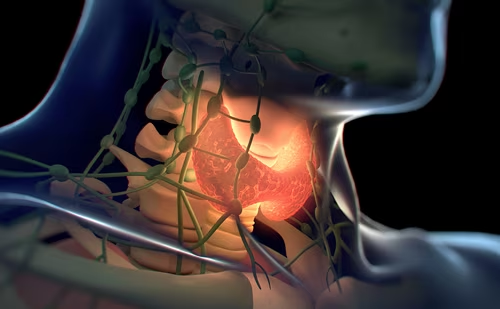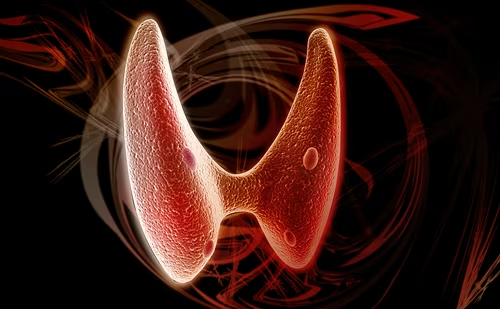Autoimmune hyperthyroidism due to Graves’ disease is the most common form of thyroid hyperfunction in iodine-sufficient areas. Ultimately, it is caused by autoantibodies that interact with the thyroidstimulating hormone (TSH) receptors on thyroid follicular cells – i.e. the TSH-receptor antibody (TRAb) – and thereby cause uncontrolled stimulation of thyroid function and growth.1 Currently, pathogenic treatments to prevent the cause of the disease are not available.
Autoimmune hyperthyroidism due to Graves’ disease is the most common form of thyroid hyperfunction in iodine-sufficient areas. Ultimately, it is caused by autoantibodies that interact with the thyroidstimulating hormone (TSH) receptors on thyroid follicular cells – i.e. the TSH-receptor antibody (TRAb) – and thereby cause uncontrolled stimulation of thyroid function and growth.1 Currently, pathogenic treatments to prevent the cause of the disease are not available. For this reason, current therapies for Graves’ hyperthyroidism either destroy the sick thyroid (thyroidectomy, radioiodine therapy) or control hyperthyroidism by drugs (thionamides) while waiting for spontaneous disease remission.2 It is beyond the scope of this short article to discuss the advantages and disadvantages of ablative versus non-ablative treatments.
Pharmacological Properties of Thionamides
Thionamides include carbimazole, its active metabolite methimazole (MMI) and propylthiouracil (PTU). Carbimazole is mainly utilised in the UK, MMI is the most commonly used antithyroid drug in Europe and Japan and PTU is the most prescribed thionamide in the US and South America.2 These drugs are given orally and are almost completely absorbed through the gastrointestinal tract. The serum half-life and duration of action of MMI are longer than those of PTU (see Table 1). Thus, MMI is usually given as a single daily dose while PTU, at least when treatment is started, is administered in two to three daily doses. The therapeutic potency of MMI is at least 10-fold higher than that of PTU,2 so the doses of MMI necessary to control thyroid hyperfunction are lower than those of PTU. In general, however, the choice between the two thionamides is largely due to personal preference/experience as well as local availability. For example, PTU is not easily available in Italy.
The main effect of thionamide is the blockade of thyroid hormone synthesis through the inhibition of thyroid peroxidase – the enzyme that catalyses iodide oxidation – iodination of tyrosine residues on to thyroglobulin and the coupling of iodotyrosines (monoiodotyrosine and diiodotyrosine) to form thyroxine (T4) and triiodothyronine (T3).1–3 In vitro thionamides have immunomodulatory effects that may contribute to their therapeutic action in Graves’ hyperthyroidism.4 However, whether these effects are relevant in clinical disease remains controversial.
Thionamides are generally safe drugs; side effects are usually mild and self-limiting. Serious untoward effects are observed in <5% of cases, more commonly during the initial phases of treatment when the drug dosage is higher (see Table 2).5 If an adverse effect is observed with one drug, the other thionamide can be used, but cross-reactivity is frequent (about 50%).5 Agranulocytosis (neutrophil count <0.5x109/l) is one of the most serious complications of treatment, occurring in about 0.1–0.5% of patients.5 It requires immediate drug withdrawal and prompt treatment with antibacterials and administration of granulocyte colony-stimulating factor (G-CSF).5 While there seems to be a dose-dependency of this serious complication in the case of MMI, this is lacking in the case of PTU.5 Generally, as the onset of agranulocytosis is abrupt and explosive, patients should be advised that in cases of fever, sore throat or other signs of infections a leucocyte count should be promptly obtained. Aplasia cutis, the congenital absence of skin (localised or disseminated), has been reported in a few infants born to hyperthyroid mothers given MMI during pregnancy, while no such cases have been reported following PTU treatment.6 Rare cases of embriopathy (choanal and oesophageal atresia and cardiac defects) have been reported in infants born to mothers given high doses of MMI early in pregnancy.7
Different Dose Regimens
Two different regimens of thionamide therapy are commonly used. The first, the titration method, is aimed at using the lowest thionamide dose to maintain euthyroidism; the second, the block-and-replace method, employs consistently high doses of thionamides to complement a levothyroxine (L)-T4 replacement to avoid hypothyroidism (see Table 3). In the titration method, the usual starting dose of thionamides is 15–40mg/day for MMI, either in a single dose or in divided doses, or 300–400mg for PTU, always in divided doses. The initial dose (lower versus higher) depends mainly on the severity of the hyperthyroidism. After a few weeks, daily dosage is reduced to the lowest effective dose. In many instances, a daily dose of 2.5–5mg of MMI or 50–100mg of PTU is enough to achieve euthyroidism after four to 12 weeks and, thereafter, to maintain it. An assessment of thyroid status should be made every four to six weeks for the first four to six months, and then every three to four months until treatment is withdrawn, usually after 18 months.
In the block-and-replace method, after the first few weeks thionamide treatment is continued at high doses, and L-T4 is added to prevent the occurrence of hypothyroidism.8 This regimen has advantages and disadvantages compared with the other method. Higher doses may theoretically have immunosuppressive effects that are useful to obtain permanent remission of the disease. With the block-and-replace method avoidance of hypothyroidism seems simpler than with the titration method, treatment is shorter (six months) and the number of visits lower. On the other hand, the prolonged use of higher doses of thionamides (e.g. 30–40mg/day of MMI) is more likely to expose the patient to a higher risk of untoward effects and complications. In addition, the high number of tablets that the patient must take every day may create problems of poorer compliance. Finally, the cost of this combined treatment is higher, at least in the six-month period.2 A recent systematic review of randomised or quasi-randomised studies showed that that the block-and-replace regimen does not offer any advantage in terms of permanent remission of hyperthyroidism, while it bears a higher risk of side effects.9 However, the latter conclusion has recently been questioned.10 I personally favour the use of the titration method as the therapeutic regimen of choice for antithyroid drug therapy, but other authors may equally prefer the block-andreplace method.
A third therapeutic regimen of antithyroid drug therapy was proposed several years ago in Japan.11 After restoring euthyroidism with MMI alone, patients were randomised to continue for 12 months with either MMI alone or MMI and L-T4. The latter group then continued treatment with L-T4 for an additional 36 months. Relapses in the L-T4- treated group were significantly and remarkably rarer than in the group not receiving L-T4 (2 versus 35%).11 Unfortunately, these results have not been confirmed by several subsequent studies.12–18 The reason for this discrepancy is elusive, but the number of negative studies suggests that the continuation of L-T4 therapy after thionamide withdrawal is not useful.
Duration of Treatment
Early studies suggested that short-term thionamide treatment (three to four months) was as effective as long-term treatment (12–18 months). However, using the titration method, more recent studies have documented that a 18-month treatment regimen with carbimazole is associated with a significantly lower relapse rate than a six-month treatment programme.19 On the other hand, continuation of thionamide therapy up to 24 or 42 months does not seem to increase the rate of permanent remission after antithyroid drug treatment,20 although the use of high doses of thionamides may be associated with a longer relapse-free period.21 Using the block-and-replace method, prolongation of treatment from six to 12 months does not increase the likelihood of a permanent remission of hyperthyroidism.22 Thus, using the titration method, the best duration of treatment is 18 months, whereas with the block-and-replace method treatment should be discontinued after six months.
Treatment Outcomes
The major drawback of thionamide treatment is its poor outcome, because about 40–60% of patients have a relapse of hyperthyroidism, which mostly occurs within the first year after discontinuation of treatment.23 There are no reliable predictors of the outcome of thionamide treatment. However, patients with large goitres that do not shrink during treatment, severe hyperthyroidism that is difficult to control even with relatively high doses of thionamides (20–30mg/day MMI or equivalent) or TRAb levels that do not decrease during treatment are good candidates to have relapsing hyperthyroidism.23 Patients with these characteristics may be candidates for longer thionamide treatments, but whether the long-term outcome is improved in such a way is uncertain.24 Failure of TRAb to become undetectable is almost invariably associated with a relapse of hyperthyroidism after thionamide discontinuation, but also patients whose TRAb levels become undetectable during treatment have a relatively high chance of treatment failure.23 Men have a lower remission rate than women, while age <40 years seems to be associated with a higher relapse rate,25 possibly because hyperthyroidism tends to be less severe in the elderly. Smoking has been reported to reduce the likelihood of achieving a stable remission of hyperthyroidism (see Table 4).18–26 A recent systematic review of published randomised controlled trials showed that there is no difference in terms of treatment outcome between the titration method and the block-and-replace method.9
Future Developments
Ideal treatments should affect the immunological pathogenic mechanisms of Graves’ disease.27 This may be obtained by interfering with TRAb binding to the TSH receptor and subsequent stimulation of thyroid hormone synthesis. There are interesting in vitro studies on the use of monoclonal antibodies modulating TRAb action, but the relevance and application of these agents in clinical practice remains to be assessed.
A pharmacological agent that may find a role in the management of Graves’ hyperthyroidism is rituximab. This is a chimeric monoclonal antibody directed against the CD20 antigen expressed on the surface of immature and mature B cells (but not stem cells or plasma cells).28 After being used with success in non-Hodgkin’s lymphomas, this drug has been utilised with encouraging results in a number of autoimmune disorders.27 In relation to Graves’ disease, two pilot studies have shown that rituximab may have favourable effects on both hyperthyroidism, at least in terms of delaying (or preventing) recurrence,29 and the most important extrathyroidal expression of Graves’ disease, the orbitopathy.30 If these preliminary results are confirmed by large randomised, controlled studies, this drug may be a potent weapon for a novel approach to management of Graves’ disease.■







